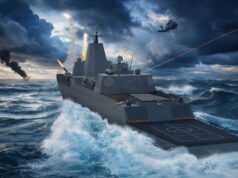The Royal Navy launched a missile from its autonomous boat MADFOX during NATO’s biggest autonomous war games.
In a news release, the Royal Navy say that innovation experts NavyX deployed to Portugal with uncrewed technology for the annual experimentation exercise.
“The two-week exercise aimed to test the integration of NATO systems and explore existing and new military roles for autonomy. At the centre of the Royal Navy’s contribution was the MADFOX crewless boat which has been undergoing trials all year. During it’s first overseas deployment, the boat was tasked with its biggest test to date – being part of a surveillance training operation ending in a missile launch. “
For the trial, a Puma drone launched by USNS Carson City relayed information to a land-based control centre of a possible target – in this case a simulated target of a Spanish crewless boat. Once received, that information was sent to the Royal Navy’s MADFOX vessel and the missile launched.
Commander Antony Crabb, NavyX Experimentation Team Leader, said:
“The system launch from MADFOX was a UK first, demonstrating the potential of uncrewed surface vessels for lethal and other payloads; crucially, the whole serial was commanded, enabled and facilitated using information provided by uncrewed systems. It is a significant step for UK/US interoperability and interchangeability.”
Later in the exercise, Royal Navy technology supported night-time amphibious operations. It saw MADFOX observe a ‘target’, undetected, and provide live imagery using its onboard cameras.
“As Portuguese Marines stormed ashore, aerial drones provided further surveillance, sending imagery to ruggedised tablets within the assault forces. Personnel in the Maritime Operations Centre were able to make an assessment of the target defences and enemy strength before ordering an attack. The exercise was designed to show how dismounted Command and Control systems could extend situational awareness provided by uncrewed systems to small distributed teams. The tablets also enabled the Marines to request missions from the uncrewed systems connected to the UK MAPLE mission planning system.”













What kind of missile?
I don’t know the answer, but I’d hazard a guess at the Martlet lightweight missile. It’s light, relatively small and I’m sure there are lessons learned from integrating it on the T23. Nice to see an unmanned naval platform with some teeth!
M@
Switchblade 300 apparently
Switchblade 300. The UK’s investment into the system was confirmed back in March.
Switchblade 300 – a smaller loitering munition (single-use kamikaze drone).
It’s a pretty small device, 10km and very small warhead, but it’s pretty precise and portable.
Not come across this before, but doing a quick google search and it seems to be grenade level of explosives, which doesn’t seem big enough to do much on a naval level, beyond destroying ribs.
For testing the concept, the smaller the better. We wouldn’t want anything bigger going rogue and sinking an allied vessel. Future tests will be worth watching, from a safe distance!
Yes, definitely not a large scale anti-ship device. I think they are mostly used for light vehicles or specific targets in concealed positions (basically like regular grenades, just with a far greater range).
I think they are exploring models with heavier payload but these will probably just be used for smaller targets like RHIBs or maybe light shore targets if given any practical use – most likely it will just be a stepping stone onto bigger stuff.
pointless without real punch
Switchblade 300 seems to have an anti-personnel warhead the whole drone is about the size of a Pringle can and it weighs only 2.5kg, the Switchblade 600 is longer (about the length of an umbrella) ever so slightly wider and has about 3x the range performance its warhead is taken from a Javelin anti-armor missile however it weighs 55kg!
Switchblade 300, straight to the target unless it blowing a blinder wind speed would dictate deployment YES/ NO ?
What is the range of the 300? I would guess pretty limited if it’s that size. I’m struggling to see any realistic miltiary use for such a thing from a naval ship.
Interesting article on switchblade below:
https://www.thedrive.com/the-war-zone/42755/new-tracked-unmanned-vehicle-bristles-with-a-whopping-50-switchblade-suicide-drones
Hi Steve Switchblade 300 SPECS flight duration 15mins Range 10km Speed at Cruising 63mph Dash to target DOT 100mph Total Weight Inc warhead 5.5 lbs fits in a rucksack Table controlled with in built camera
TABLET not Fxxxing TAble sorry Steve predictive txt
10km – you could use 2-3 of these combos to monitor a choke point like straights of Hormuz for swarming fast boats. 300 is precise – it can take out the driver or outboard. 600 will put a hole in anything at 60km range.
Boghammer coxswain’s are all for getting to Paradise, usually when they hit their Target , Switchblade 300/600 could get them there quicker before they get a chance too shout their Catchphrase !!!
Probably a firework, Roman candle on the bow too, apparently very impressive……
At this stage I think that is almost irrelevant. Proving the concept was the aim. In the future, both the type of drone vessel and missile can be changed. Almost certainly with many other possible features too.
Just a thought for discussion. I wonder if a low cost drone vessel can be given a switchable radar cross section. Enabling it to act as a decoy aircraft carrier when needed and for flexibility, also pack some useful defensive missiles. Must we wait for autonomous AI before such things become available. In the current uncertain climate, I sincerely hope some boffin is already on the job.
I think you would struggle to make the RCS that big from something that small even with lenses.
Making a River sized RCS maybe.
Wonder if a spear 3 could be launched from such a craft? A tiny radar signature could loiter in packs and and then sneak in and fire a salvo without risking anyone and I’m guessing it has a good loitering capabilities days or even weeks in a sleep mode.
Never say never!
Saab and MBDA have disclosed that they are working together on the development of a miniaturised powered decoy that will form part of Saab’s Arexis airborne electronic warfare (EW) product portfolio.
https://www.janes.com/defence-news/weapons-headlines/latest/saab-reveals-mbda-link-as-arexis-air-launched-decoy-breaks-cover
I think the brimstone Family would be a good choice given solid fuel rather than air breather solution on Spear3. The 40km 10kg warhead version of brimstone or the 20km 16kg warhead (seaspear ver) would be great options for both land and naval targets.
Brimstone has already been tested at sea and successfully hit all fast attack targets.
https://www.mbda-systems.com/product/maritime-brimstone/
I know it’s why I’m advocating their use for the drone vessel, especially the sea spear version. Some heavier punch and would allow the use of these drone vessels in a similar fashion to the MTB’s in WWII or the Reaper UAV for the airforce. Loiter, and if required launch up to 20 km away and scoot.
Personally a fan of putting 8 x sea spear onto type 31 as well once the base vessels are delivered and commissioned. Low cost with massive flexibility and utility for vessels operating in isolation across the globe.
Cheers
I’d agree these weapon systems are also candidates to containerise. Containers would make our weapons system more sellable US will always be able to offer a cheaper system as they have the volumes. We need to increase the user base to get a lower cost.
tested on the sutherland
That was Maerlet, not Brimstone.
(Unless I have missed a trial)
This could be a good addition to the old “Arsenal Ship” concept but if the bean counters get their way we will end up with a fleet of remotely operated speed boats armed with a couple of flash-bangs. Let us just hope that that there is a joined up approach by the people in the MoD who are responcible for the future of the RN and the UK’s armed forces in general.
Much as I like the experimental approach, one wonders if too many toys will muddy the waters? I can see the benefit of a small cheap drone but only essentially chucking a hand grenade? The vulnerability of the drone craft is also an issue.
I am also a fan of the spear3 missile and with its loitering ability it is a wonder that it has not been renamed as a drone to gain political acceptance…
Having the task group in the South China Sea is all very well, but the size of their navy in home waters makes me shudder, as does the arsenal of AShM at their disposal.
It may only be small, but accurate, and having 200 or so at your disposal spread across the fleet, including F35 air launched ones in a combined ew and explosive attack, followed by a few larger missiles….got to be good?
AA
I agree, the RAF are now bringing out the wingman concept and from the look of things this could work the same way. I just hope that the bean counters see it the same way.
i hope they can be turned out at a fast rate to work with new frigates e.t.cc
never mind all this, how good is the laser system? and when will we know anything about it?
reminds me of the iranian copy of a bradstock marine speedboat which they put a single cruise missile on maybe an anti submarine version to operate around our sensitive shoreline areas which seem to be covered by a single home waters t23 a swarm of these craft opating with a t31 could be an interesting option
great news it shws british design an ingenuity can still be at the fore front of new technologies
i wonder if a few could operate from inside a bay class